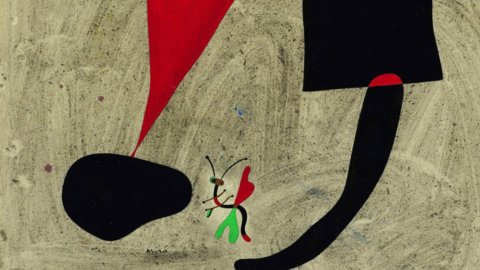The Bano Foundation and the Municipality of Padua welcome, as a world premiere outside the Portuguese territory, the very important Miró Collection preserved in the city of Porto, in the seat of Palazzo Zabarella, in the heart of Padua, froml 10 March to 22 July 2018.
In his exploration of materiality, Miró was matched perhaps only by Paul Klee. Certainly Miró decisively expanded the boundaries of twentieth-century artistic production techniques.
And the exhibition itinerary, focusing on the transformation of the pictorial languages that the Catalan artist began to develop in the first half of the XNUMXs, documents his artistic metamorphoses in the fields of drawing, painting, collage and tapestry works.
The exciting sequence of works proposed by the exhibition highlights Miró's visual thinking, the way in which he was able to work with all the senses, from sight to touch, and at the same time explores the elaboration processes of his creations.
The works were owned by the Banco Português de Negociós, which between 2004 and 2006 had purchased them from an important Japanese private collection. In 2008 Banco was nationalized by the Portuguese State which, in a phase of severe economic difficulties, decided to put the prestigious Collection on the market. Christie's was in charge of the sale which, in 2014, decided to auction it at its London office.
This led to an immediate protest, and the auction was first postponed and then cancelled, so Miró's works remained in Portugal. They were publicly exhibited for the first time at the Serralves Museum in Porto, between October 2016 and June 2017, in an exhibition that had over 240.000 visitors, an event that proved to be one of the most successful exhibitions of the recent Portuguese exhibition season. Before reaching Padua, the collection was also hosted by the Ajuda National Palace in Lisbon with the same title, Joan Miró: Materiality and Metamorphosis.
The shows that Zabarella Palace offers to his audience, covers a period of six decades of Joan Miró's career, from 1924 to 1981. Focusing in particular on the transformation of the pictorial languages that the Catalan artist began to develop in the first half of the XNUMXs. It documents his artistic metamorphoses in the fields of drawing, painting, collage and tapestry works. Miró's visual thinking, the way he works with the senses, from sight to touch, and the elaboration processes of his works are observed in detail.
Throughout his career, Joan Miró (1893-1983) always reaffirmed the importance of materiality as the foundation of his artistic practice. This does not mean that the materials imposed all aspects of the depiction on him: at various times he produced elaborate preparatory sketches for even the most spartan and apparently spontaneous works. But there is no doubt that the relationship between medium and technique influenced all aspects of his production, from his first paintings and collages to his latest works in the form of sculptures and tapestries.
The inventory of physical supports used by Miró in seventy years of artistic activity includes traditional materials, such as canvas (mounted on a frame or not, torn, worn or perforated), different types of wallpaper, parchment, wood and cardboard (cut and corrugated), but also glass, sandpaper, jute, cork, sheepskin, fiber cement, brass, chipboard, Celotex, copper, aluminum foil and tar paper.
The materials – which always establish a delicate balance with the support – include oil, acrylic colours, chalks, pastels, Conté pencils, graphite, egg tempera, gouache, watercolour, enamel paint, India ink, collage, stencils and decals . Innovatively applied on both traditional and unorthodox bases: plaster, casein and tar, sometimes combined with an eclectic range of common objects and everyday materials, such as linoleum, rope and thread.
In the dual role of creator and transgressor of the form of twentieth-century modernism – painter and anti-painter at the same time – Miró challenged the very notion of the specificity of the medium, as this extensive survey has the merit of spectacularly highlighting.
Image (detail): Joan Miró, Nature morte au papillon, 18 September 1935. Gouache and India ink on paper, 30.5×37 cm. Filipe Braga, © Fundação de Serralves, Porto. For all the works of Joan Miró ©Successó Miró by SIAE 2018





